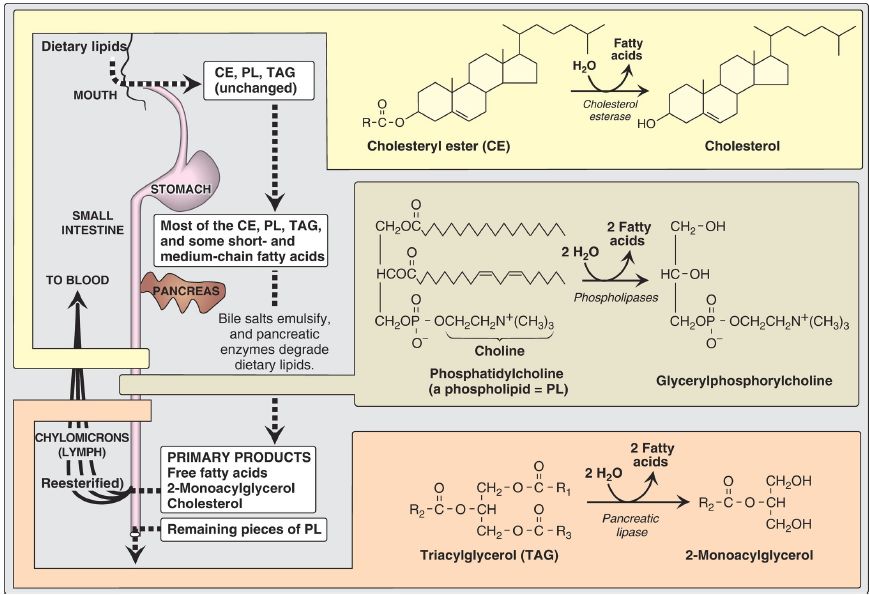


 النبات
النبات
 الحيوان
الحيوان
 الأحياء المجهرية
الأحياء المجهرية
 علم الأمراض
علم الأمراض
 التقانة الإحيائية
التقانة الإحيائية
 التقنية الحيوية المكروبية
التقنية الحيوية المكروبية
 التقنية الحياتية النانوية
التقنية الحياتية النانوية
 علم الأجنة
علم الأجنة
 الأحياء الجزيئي
الأحياء الجزيئي
 علم وظائف الأعضاء
علم وظائف الأعضاء
 الغدد
الغدد
 المضادات الحيوية
المضادات الحيوية|
Read More
Date: 5-1-2022
Date: 31-8-2021
Date: 1-10-2021
|
Lipid Degradation by pancreatic enzymes
The dietary TAG, cholesteryl esters, and phospholipids are enzymatically degraded (digested) in the small intestine by pancreatic enzymes, whose secretion is hormonally controlled.
1. Triacylglycerol degradation: TAG molecules are too large to be taken up efficiently by the mucosal cells (enterocytes) of the intestinal villi. Therefore, they are hydrolyzed by an esterase, pancreatic lipase, which preferentially removes the FA at carbons 1 and 3. The primary products of hydrolysis are, thus, a mixture of 2-monoacylglycerol (2-MAG) and FFA (Fig. 1). [Note: Pancreatic lipase is found in high concentrations in pancreatic secretions (2%–3% of the total protein present), and it is highly efficient catalytically, thus insuring that only severe pancreatic deficiency, such as that seen in CF, results in significant malabsorption of fat.] A second protein, colipase, also secreted by the pancreas, binds the lipase at a ratio of 1:1 and anchors it at the lipid–aqueous interface. Colipase restores activity to lipase in the presence of inhibitory substances like bile salts that bind the micelles. [Note: Colipase is secreted as the zymogen, procolipase, which is activated in the intestine by trypsin.] Orlistat, an antiobesity drug,
inhibits gastric and pancreatic lipases, thereby decreasing fat absorption, resulting in weight loss.
2. Cholesteryl ester degradation: Most dietary cholesterol is present in the free (nonesterified) form, with 10%–15% present in the esterified form. Cholesteryl esters are hydrolyzed by pancreatic cholesteryl ester hydrolase (cholesterol esterase), which produces cholesterol plus FFA . Activity of this enzyme is greatly increased in the presence of bile salts.
3. Phospholipid degradation: Pancreatic juice is rich in the proenzyme of phospholipase A2 that, like procolipase, is activated by trypsin and, like cholesteryl ester hydrolase, requires bile salts for optimum activity. Phospholipase A2 removes one FA from carbon 2 of a phospholipid, leaving a lysophospholipid. For example, phosphatidylcholine (the predominant phospholipid of digestion) becomes lysophosphatidylcholine. The remaining FA at carbon 1 can be removed by lysophospholipase, leaving a glycerylphosphoryl base (for example, glycerylphosphorylcholine, see Fig. 1) that may be excreted in the feces, further degraded, or absorbed.
4. Control: Pancreatic secretion of the hydrolytic enzymes that degrade dietary lipids in the small intestine is hormonally controlled (Fig. 2). Cells in the mucosa of the lower duodenum and jejunum produce the peptide hormone cholecystokinin (CCK), in response to the presence of lipids and partially digested proteins entering these regions of the upper small intestine. CCK acts on the gallbladder (causing it to contract and release bile, a mixture of bile salts, phospholipids, and free cholesterol) and on the exocrine cells of the pancreas (causing them to release digestive enzymes). It also decreases gastric motility, resulting in a slower release of gastric contents into the small intestine .
Other intestinal cells produce another peptide hormone, secretin, in response to the low pH of the chyme entering the intestine from the stomach. Secretin causes the pancreas to release a solution rich in bicarbonate that helps neutralize the pH of the intestinal contents, bringing them to the appropriate pH for digestive activity by pancreatic enzymes.
 Figure 1: Overview of lipid digestion.
Figure 1: Overview of lipid digestion.

Figure 1 :Hormonal control of lipid digestion in the small intestine. [Note: The small intestine is divided into three parts: the duodenum (upper 5%), the jejunum, and the ileum (lower 55%).]



|
|
|
|
علامات بسيطة في جسدك قد تنذر بمرض "قاتل"
|
|
|
|
|
|
|
أول صور ثلاثية الأبعاد للغدة الزعترية البشرية
|
|
|
|
|
|
|
مكتبة أمّ البنين النسويّة تصدر العدد 212 من مجلّة رياض الزهراء (عليها السلام)
|
|
|